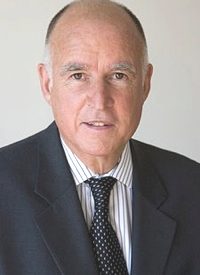
California’s Gov. Jerry Brown, who took office with a state government in horrific financial shape, is continuing to press for so-called “renewable energy.” A bill which has passed the state legislature and which he intends to sign into law could require that by 2020, California utilities would have to draw 33 percent of their power from solar panels, windmills, landfills gases, small hydroelectric power plants, and similar renewable sources.
U.S. Department of Energy Secretary Steven Chu plans to attend Brown’s signing of the bill into law at SunPower-Flextronics, a solar manufacturing plant near San Francisco. Energy Department spokeswoman Stephanie Mueller observed of Governor Brown’s efforts, “Instead of watching from the sidelines, America needs to get back in the clean energy race, and that is exactly what California is doing.”
Many are predicting that the economic impact of the bill will be to raise the already-high cost of electricity for Californians. Gino DiCaro of the California Manufacturers and Technology Association observed, “Industry in California already pays electricity rates about 50 percent higher than the rest of the country; with 33 percent, those rates are going to go up even more.” Business groups predict that this legislation will push electric power costs up at least another seven per cent, even though the bill includes language to limit costs by government fiat. There seems little question that coal and natural gas — traditional fuels for generating electrical power — are cheaper. Brown promised to review any cost increases which the legislation might cause, but added:
I know one thing: Being dependent on foreign fossil fuel is not good for our economy, it’s not good for our security, and it’s not good for our climate. We have to be bold.
Former Governor Arnold Schwarzenegger had vetoed similar legislation, although he also issued an executive order calling for the same reliance of utilities upon renewable energy. The new law is expected to cost tens of billions of dollars just in new capital investment for generation equipment and transmission lines. These costs, of course, are passed along to ratepayers of the state’s investor-owned and municipal utilities — families struggling to make ends meet and businesses trying to remain profitable. Many people and businesses are moving out of California precisely because it has become too expensive to live in the state. As these taxpayers and job creators depart, state revenues will naturally drop. California already has a per capita state debt of over $9,800 per person. State debt now exceeds state revenue, and state spending is growing more quickly than state revenue.
Though “renewable” energy is often confused with “clean” energy, the two are not the same at all. Natural gas, for example, is about as clean as energy gets, as is the production of hydroelectric power from large, efficient dams and giant reservoirs. These two methods of energy production have been targeted by environmentalists on the grounds that their sources are not “renewable” or, in the case of big dams, that the dam may affect the environment. Nuclear power is also extraordinarily clean — as clean as natural gas, really – and it is also renewable in the sense that it can produce power for a long time with only a modest byproduct.
So how “clean” is energy production in California now? A whopping 57 percent of electricity is produced by very clean natural gas; another 15 percent comes from nuclear power; and 12 percent from large-scale hydroelectric power facilities. So from these efficient, clean, and economical power generation sources, California utility companies produce 84 percent of the state’s electricity. If “clean” is the goal, then California is already there.
Renewable energy, on the other hand, is not exactly clean. Wind power create noise pollution which disturbs nearby residents. Furthermore, the vast blades of the giant windmills are not safe for wildlife, killing a vast number of birds every year and so threatening the “fragile” ecosystem. According to a 2009 article in the Wall Street Journal, a study of the wind farm at Altamount Pass, California “estimated that about 10,000 birds — nearly all protected by the Migratory Bird Act — are being [killed] every year at Altamount.”
Also, the Kennedy clan and many others have complained that these giant wind turbines are “polluting” the scenery.
Constitutionalists know that the mandates of state government that utilities use so-called “renewable” energy is just another way for Big Brother to interfere with the economy in a way that drives down the standard of living and makes operating a small business even more difficult. At a time when Californians are facing a deluge of illegal immigrants, when the state government is for all intents and purposes broke, when productive citizens and businesses are packing up and moving to Nevada, Utah, or Arizona, one might think that the politicians in Sacramento would have more to worry about than their idée fixe with “renewable” energy.
Conservative analysts are urging that the state end its meddling with energy and let the private market sort out the most cost-effective way to give Californians electricity; that they end or at least loosen the environmental regulations that keep farmers from getting water to irrigate crops; and that they allow offshore drilling, which would drive down the price of oil and bring into the state treasury sizable royalties.



